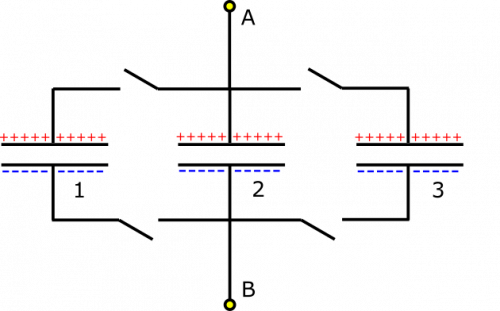This is an old revision of the document!
Connecting Already-Charged Capacitors
Suppose you have the following setup of already-charged capacitors. The positive plates are all on the top half of the circuit. Capacitors are labeled 1 through 3 for convenience of reference, and the sign of the charge on the plates is indicated. You know that Q1=Q2=Q3=1 mC, and ΔV1=ΔV2=ΔV3=20 V. What is the equivalent capacitance (if the switches are closed) from Node A to Node B? What happens after the switches are closed? What if Capacitor 2 were flipped?
Facts
- Q1=Q2=Q3=1 mC
- ΔV1=ΔV2=ΔV3=20 V
- Capacitors are aligned as shown in picture.
- Capacitor 2 is flipped in the second case.
Lacking
- Cequiv
- Explanations for what happens after the switches are closed, in both cases.
Approximations & Assumptions
- The potential differences across the segments of wire are very very small in comparison to the potential differences across the capacitors.
Representations
- We represent capacitance as C=QΔV
- We represent the Loop Rule (for potential difference within a closed loop) as
ΔV1+ΔV2+ΔV3+…=0
- We represent the equivalent capacitance of multiple capacitors arranged in parallel as
Cequiv=C1+C2+C3+…
- We represent the situation with diagram given above. The flipped situation is below.
Solution
All the charges and potential differences across the capacitors are the same, so they should have the same capacitance: C1=C2=C3=QΔV=50μF Now, we can find the equivalent capacitance from Node A to Node B, since the capacitors are arranged in parallel: Cequiv=C1+C2+C3=150μF
Okay, so what happens when we closed all the switches? Now the capacitors are connected to one another. A good check to see if charge will move involves the potential differences across the capacitors. The notes tell us that the potential differences across parallel capacitors will be the same in a steady state. If they are not the same, we can use the Loop Rule to show there is a voltage difference along the wire, which will cause charge to flow between capacitors. We are happy to see that the potential differences across our capacitors are the same, so the setup is already in a steady state! Nothing changes when the switches are closed.
In the case that Capacitor 2 is flipped, we have the setup shown in the representations list. When we check the potential differences in the different capacitors, we notice that the voltage across Capacitor 2 is the opposite as the voltage across the other capacitors. If we travel from Node B to Node A, we could travel through Capacitor 2 and go through ΔV2=−12 V, or through one of the other capacitors and go through ΔV1,3=+12 V. These are different, but that can't be! There must be some potential difference in the wire that we are not accounting for. This potential difference will cause charge to flow. The only question is how.
If we consider that charge cannot flow across a capacitor, we know that the top half and the bottom half of the setup cannot exchange charge. So the total charge on top is 50μF, and the total charge on the bottom is −50μF. In order to reach a steady state, since each capacitor is the same, the charge should spread out evenly among the capacitors. So we end up with each capacitor begin charged to 16.67μF. This way, charge is conserved on the top and bottom, and each capacitor is charged to the same amount. The steady state should look the original diagram given, just with less (a third, to be exact) of the charge built up on the plates.

